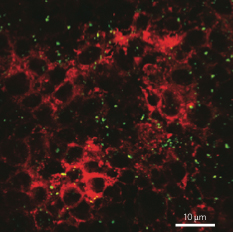Nanoparticles in food, vitamins could harm human health
February 20, 2012
Billions of engineered nanoparticles in foods and pharmaceuticals are ingested by humans daily, and new Cornell University research warns they may be more harmful to health than previously thought.
The researchers studied how large doses of polystyrene nanoparticles — a common, FDA-approved material found in substances from food additives to vitamins — affected how well chickens absorbed iron, an essential nutrient, into their cells.
According to the study, high-intensity, short-term exposure to the particles initially blocked iron absorption, whereas longer-term exposure caused intestinal cell structures to change, allowing for a compensating uptick in iron absorption.
The researchers tested both acute and chronic nanoparticle exposure using human gut cells in petri dishes as well as live chickens and reported matching results. They chose chickens because these animals absorb iron into their bodies similarly to humans, and they are also similarly sensitive to micronutrient deficiencies, explained the paper’s first author Gretchen Mahler.
Intestinal villi remodeling
The researchers used commercially available, 50-nanometer polystyrene carboxylated particles that are generally considered safe for human consumption. They found that following acute exposure, a few minutes to a few hours after consumption, both the absorption of iron in the in vitro cells and the chickens decreased.
But following exposure of 2 milligrams per kilogram for two weeks — a slower, more chronic intake — the structure of the intestinal villi began to change and increase in surface area. This was an effective physiological remodeling that led to increased iron absorption.
“This was a physiological response that was unexpected,” Mahler said.
Research leader Michael Shuler noted that in some sense this intestinal villi remodeling was positive because it shows the body adapts to challenges. “Nanoparticles are entering our environment in many different ways,” Shuler said. “We have some assurance that at a gross level they are not harmful, but there may be more subtle effects that we need to worry about.”
Ref.: Gretchen J. Mahler, et al., Oral exposure to polystyrene nanoparticles affects iron absorption, Nature Nanotechnology, 2012; [DOI:10.1038/nnano.2012.3]
